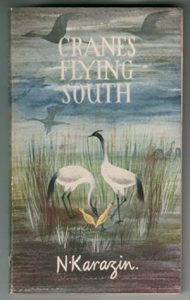Cranes Flying South was written in 1899 and its Russian author, Nikolay Nikolaevich Karazin was a military officer and painter (specialising in war and exotic places) as well as writer. At one point (1948) a translation of it was published by Puffin books and there was a pile of these in the English stock cupboard when I started my first teaching job in 1968. So I read it and “did” it with a couple of classes without, as far as I remember, resounding success. But it’s a novel I’ve thought about on and off over the years because it taught me a few things about bird migration. What would I think of it now?
You can still buy it via Amazon courtesy of Kessinger’s Legacy Reprints which is presumably a series. The book I bought is actually a facsimile of a 1931 Junior Literary Guild New York edition translated from the Russian by M Pokroysky and illustrated by Vera Bock. It came from the US and took a while to arrive.

Two crane chicks, one male, one female, hatch in the Great Oshtashkovo Marshes in western Russia. The male narrates the story. As soon as they have fully functioning wings it’s time for their colony to migrate south to Africa so this account of their journey is actually yet another quest story. Of course there are obstacles and difficulties to beset them en route. The storm over the eastern Mediterranean which leads to some of them landing on a passenger boat taking pilgrims to Jerusalem is quite nicely done, for example. Inevitably some birds fail to make it to the ultimate destination. It is a classic case of the survival of the fittest.
The bird’s eye descriptions of the places they pass over or through are some of the best things in the book: Ukraine, Kiev, Rivers Dnieper and Danube, Black Sea, Marmora Sea and Turkey. Cyprus is the plan but because of the storm instead they fly into Egypt from Beirut and then south into the Sudan, noting war in Khartoum as they go. If I were teaching this novel now I’d have the students construct an annotated map to show the route these birds take.
I’d also be asking them to think about anthropomorphism and make a chart in two columns listing things that cranes do in real life and what they don’t. Birds don’t, for example, blush, help each other out, have children, worship God or hold philosophical discussions. On the other hand cranes do organise themselves into flight triangles, have leaders and eat fruit and legumes from the farmed fields they land in – which is why human beings tend to be less than friendly.

When the birds arrive in Africa the narrator casually refers to blacks, natives and savages which jars for a 21st century reader. I think it’s partly because this is a book of its time. A hundred and twenty five years ago such language was, regrettably, the norm especially in America. Second, it may be a translation issue. I have no way of telling which words Karazin actually used and how nuanced his language might have been compared with the options available to the translator.
So this book is a bit of an antique curiosity but worth reading for its colourful descriptions and sense of what an enormous feat that long annual migration to warmer climes is. Amazon and other sites which have copies have lots of comments from people who remember the book from school with affection. I had long assumed that it was very niche. In fact such memories show that it must been quite a common English department acquisition in the 1950s and 60s. I wonder how popular it was, or even is, in Russia?
Next week on Susan’s bookshelves: Cider with Rosie by Laurie Lee.